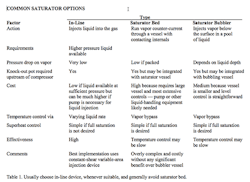Scrutinize Superheating Of Compressor Feed
Compressor suction saturators can serve to reduce superheating of compressor feeds — perhaps even to drop the compressor suction all the way to the dew point at the inlet. The two major reasons to decrease or eliminate superheat in compressors are (1) to control the temperatures in the compressor or (2) to cut the head required.
[pullquote]
The gas’s temperature rises in its journey through the compressor. If the inlet temperature is too high, the outlet temperature will be too high. Two of the many reasons for wanting to control temperatures in a compressor are to avoid interstage cooling requirements and to reduce fouling.
In cryogenic liquid storage, heat gains vaporize part of the liquid. The vapor formed typically is called boil-off gas (BOG). The BOG, if not usable, must be compressed and then recondensed. A BOG compressor often has very cold suction conditions. This allows the compressor to have multiple stages and achieve high discharge pressures without needing interstage cooling. For such a compressor, a refrigeration system would have to provide the interstage cooling. So it’s convenient and cost effective to avoid the interstage cooling. Essentially, the compressor is its own refrigeration system. The temperature limit in this case comes from the limits on the seal system in the compressor.
In other systems, reactive feeds foul the compressor. The hotter the operating temperature is, the higher the reaction rate — and the fouling rate. Cooling the compressor feed increases run duration between cleanings and reduces machinery problems from fouling deposits. In extreme cases, some reactive systems (such as certain polysilicon ones) become explosive if the temperature gets too high.
Finally, reducing compressor temperature can increase compressor capacity. Lower temperature feed has a higher density, so more mass can enter a capacity-constrained positive displacement compressor. In a centrifugal compressor, the lower temperature (and higher density feed) decreases the polytropic head required for a given discharge pressure.
Two types of suction desuperheaters — in-line and saturator bubbler — find widespread use. Another option is a saturator bed. Table 1 compares the three.
Table 1. Usually, choose an in-line device, whenever suitable, and generally avoid the saturator bed.
As long as a liquid source with enough pressure is available, the cheapest option clearly is an in-line desuperheater. It allows easy control of the amount of superheat. This type of desuperheater requires injecting liquid through a spray device into the vapor. This imposes pressure drop on the liquid. The best implementation uses a variable-area constant-shear (constant pressure drop) injection system. This helps keep the liquid drop size constant. Cheaper devices that allow the pressure drop across the nozzle to change with flow rate can have problems with large liquid droplets under some operating conditions.
If liquid isn’t available at high enough pressure, a bubbler often is a good choice. The liquid only needs to be at the gas pressure. Vapor is bubbled through a distributor below the liquid surface to create saturated vapor. If this is acceptable, the equipment is simple and nearly foolproof. Control of superheat, if necessary, will require a temperature control bypass.
The bed approach will work but often requires much higher expenses for internals and controls. So, it’s rarely used. Push back on any proposal to use one to ensure it’s really necessary.


